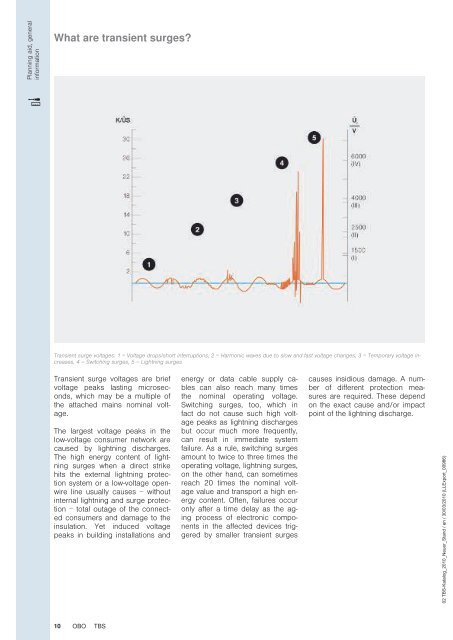Data and information technology - OBO Bettermann
Data and information technology - OBO Bettermann Data and information technology - OBO Bettermann
Planning aid, generalinformationWhat are transient surges?Transient surge voltages: 1 = Voltage drops/short interruptions, 2 = Harmonic waves due to slow and fast voltage changes, 3 = Temporary voltage increases,4 = Switching surges, 5 = Lightning surgesTransient surge voltages are briefvoltage peaks lasting microseconds,which may be a multiple ofthe attached mains nominal voltage.The largest voltage peaks in thelow-voltage consumer network arecaused by lightning discharges.The high energy content of lightningsurges when a direct strikehits the external lightning protectionsystem or a low-voltage openwireline usually causes − withoutinternal lightning and surge protection− total outage of the connectedconsumers and damage to theinsulation. Yet induced voltagepeaks in building installations andenergy or data cable supply cablescan also reach many timesthe nominal operating voltage.Switching surges, too, which infact do not cause such high voltagepeaks as lightning dischargesbut occur much more frequently,can result in immediate systemfailure. As a rule, switching surgesamount to twice to three times theoperating voltage, lightning surges,on the other hand, can sometimesreach 20 times the nominal voltagevalue and transport a high energycontent. Often, failures occuronly after a time delay as the agingprocess of electronic componentsin the affected devices triggeredby smaller transient surgescauses insidious damage. A numberof different protection measuresare required. These dependon the exact cause and/or impactpoint of the lightning discharge.02 TBS-Katalog_2010_Neuer_Stand / en / 30/03/2010 (LLExport_00986)10 OBO TBS
What pulse forms are there?Planning aid, generalinformationPulse types and their characteristics: Yellow = pulse shape 1, direct lightning strike, 10/350 µs simulated lightning pulse, red = pulse shape 2, remotelightning strike or switching operation, 8/20 µs simulated lightning pulse (Surge)02 TBS-Katalog_2010_Neuer_Stand / en / 30/03/2010 (LLExport_00986)High lightning currents can flow tothe ground during a storm. If abuilding with external lightning protectionreceives a direct hit, a voltagedrop occurs on the earthingresistor of the lightning protectionequipotential bonding system,which represents a surge voltageagainst the distant environment.This rise in potential poses a threatto the electrical systems (e.g. voltagesupply, telephone systems,cable TV, control cables, etc.) thatare routed into the building.Suitable test currents for testingdifferent lightning and surge protectorshave been defined in nationaland international standards.Direct lightning strike: Pulseshape 1Lightning currents that can occurduring a direct lightning strike canbe imitated with the surge currentof wave form 10/350 µs. The lightningtest current imitates both thefast rise and the high energy contentof natural lightning. Lightningcurrent arrestor Type 1 and externallightning protection componentsare tested using this current.Remote lightning strikes orswitching operations: Pulseshape 2The surges created by remotelightning strikes and switching operationsare imitated with test impulse8/20 µs. The energy contentof this impulse is significantly lowerthan the lighting test current ofsurge current wave 10/350 µs.Surge arrestor Type 2 and Type 3are impacted with this test impulse.TBSOBO11
- Page 1: TBS | Catalogue 2010/2011Transient
- Page 5 and 6: Contents, planning aidsBasic princi
- Page 7 and 8: Planning aid, generalinformation02
- Page 9: Negative and positive chargesStudie
- Page 13 and 14: Causes of surgesSwitching surges in
- Page 15 and 16: Zone transitions and protective dev
- Page 18 and 19: 38 OBO TBS
- Page 20 and 21: Standards, data and information tec
- Page 22 and 23: Network topologiesBus networksIn a
- Page 24 and 25: Installation instructions, lightnin
- Page 26 and 27: Terms for HF technology and install
- Page 28 and 29: Terms and explanations for PC inter
- Page 30 and 31: Selection aid, surge protection for
- Page 32 and 33: Selection aid, surge protection for
- Page 34 and 35: Selection aid, surge protection for
- Page 36 and 37: Selection aid, surge protection for
- Page 38 and 39: Test marksLightning current-testedL
- Page 40 and 41: Metallic materialsAlu—AluminiumVA
- Page 42 and 43: Tested lightning protection compone
- Page 44 and 45: The little A to Z of surge protecti
- Page 46: 212 OBO TBS02 TBS-Katalog_2010_Neue
- Page 49: Surge protection for telecommunicat
- Page 52 and 53: Surge protection for LSA-Plus syste
- Page 56 and 57: Coaxial protection devices for send
- Page 58 and 59: Surge protection for data technolog
Planning aid, general<strong>information</strong>What are transient surges?Transient surge voltages: 1 = Voltage drops/short interruptions, 2 = Harmonic waves due to slow <strong>and</strong> fast voltage changes, 3 = Temporary voltage increases,4 = Switching surges, 5 = Lightning surgesTransient surge voltages are briefvoltage peaks lasting microseconds,which may be a multiple ofthe attached mains nominal voltage.The largest voltage peaks in thelow-voltage consumer network arecaused by lightning discharges.The high energy content of lightningsurges when a direct strikehits the external lightning protectionsystem or a low-voltage openwireline usually causes − withoutinternal lightning <strong>and</strong> surge protection− total outage of the connectedconsumers <strong>and</strong> damage to theinsulation. Yet induced voltagepeaks in building installations <strong>and</strong>energy or data cable supply cablescan also reach many timesthe nominal operating voltage.Switching surges, too, which infact do not cause such high voltagepeaks as lightning dischargesbut occur much more frequently,can result in immediate systemfailure. As a rule, switching surgesamount to twice to three times theoperating voltage, lightning surges,on the other h<strong>and</strong>, can sometimesreach 20 times the nominal voltagevalue <strong>and</strong> transport a high energycontent. Often, failures occuronly after a time delay as the agingprocess of electronic componentsin the affected devices triggeredby smaller transient surgescauses insidious damage. A numberof different protection measuresare required. These dependon the exact cause <strong>and</strong>/or impactpoint of the lightning discharge.02 TBS-Katalog_2010_Neuer_St<strong>and</strong> / en / 30/03/2010 (LLExport_00986)10 <strong>OBO</strong> TBS



